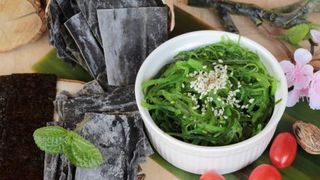Why You Should Be Eating Seaweed: Massive Nutritional Benefits, Tastes Pretty Good
Healthy and sustainable, turn to the sea for your new favourite food

Seaweed: it’s everywhere. Supermarkets are stocking it, celebrities are constantly championing it and the UK’s coastlines are lousy with it. It’s even been touted as the new kale – there’s no greater honour in the superfood world. You can eat it, use it as a seasoning or bathe in it. Seaweed’s benefits are apparently endless, so why haven’t you boarded the sea-veg bandwagon yet?
RECOMMENDED: Are Superfoods All That?
The Nutrional Benefits Of Seaweed
On nutritional value alone, seaweed deserves a place at every table. There’s no shortage of varieties – the waters around the UK alone contain over 600 types – and each of them is chock-full of vitamins and minerals.
Calcium and iron are both present – 8g of dried kombu, a brown kelp, contains more calcium than a glass of milk – and seaweed’s also one of the best sources of iodine, which is important for thyroid function. In fact, it’s got so much iodine in it that it can be dangerous, especially in brown seaweed, so if it’s brown seaweed you end up loving, eat it in moderation.
Seaweed is a rare vegetable source of vitamin B12, a deficiency in which can lead to a type of anaemia. Vitamins A, C and E are also present in useful amounts, as is soluble fibre.
It’s also low in calories. The only concern is that dried seaweed can be quite high in sodium, but this can be turned on its head. Use seaweed to replace salt in a dish.
Then there are the environmental benefits. Seaweed is easy to grow, does so at a rapid rate, and doesn’t require any extra water or fertilisers. Basically it’s the ideal food… if it actually tastes nice. So we found out.
The Seaweed Taste Test
It’s easy to get carried away with the nutritional and environmental benefits of seaweed, but it’s not going to earn a spot on anyone’s plate if it tastes terrible. Armed with a pack of Seamore I Sea Pasta, we gave it a whirl.
A post shared by Nick Harris-Fry (@nickharrisfry)
A photo posted by on
Cooking the seaweed tagliatelle is simple, just boil it for 15 minutes. In theory no salt is needed, due its natural saltiness, but a little salt wouldn’t have hurt. This is because the end result is surprisingly mild. You’d expect saltiness, fishiness, the general tang of the sea, but seaweed is actually pretty bland.
Which makes it ideal for smothering it with all the sauces you’d normally bestow on pasta. In fact, seaweed works very well as a pasta replacement, especially as the texture holds up after 15 minutes of boiling. Unlike courgetti, which turns limp the moment it touches hot water, seaweed stays slightly crunchy, like al dente pasta.
For more info on Seamore foods – including their seaweed replacement for bacon – head to seamorefood.com. You can buy their I Sea Pasta from planetorganic.com (£5.99 for 100g).
Know Your Seaweed
Sea lettuce: This leafy variety is a type of green seaweed and lives up to its name, in that it’s a great way to liven up salads.
Nori, or purple laver: One of the more recognisable seaweeds, its toasted sheets are wrapped around sushi, or eaten alone as a snack.
Dulse: When dried, dulse has a smoky flavour that’s led to it being labelled as “vegan bacon”. It’s a tasty topper for salads and soups. Like nori, dulse is classified as a red seaweed.
Kombu: The dried form of this brown seawed is an excellent addition to soups or stews, lending an umami (savoury) flavour.
Sea spaghetti: Another type of brown seaweed, this is a mild, crunchy sea vegetable that can improve a stir fry or pasta.
Where To Buy Seaweed
Cornish Seaweed Company: Choose from a variety of dried seaweed, plus skincare products and even bath bags, which promise to reinvigorate your skin and hair. cornishseaweed.co.uk
Just Seaweed: This company offers a huge range of fresh and naturally dried seaweed from the Isle of Bute, on the west coast of Scotland, processed entirely by hand. justseaweed.com.
Selwyn’s Seaweed: Dried seaweed snacks with exotic flavours like coconut and chilli or honey and sesame. Oh, and good old salt and vinegar. selwynsseaweed.com.
RECOMMENDED: Healthy Crisps: Kale, Seaweed and More Alternatives

Nick Harris-Fry is a journalist who has been covering health and fitness since 2015. Nick is an avid runner, covering 70-110km a week, which gives him ample opportunity to test a wide range of running shoes and running gear. He is also the chief tester for fitness trackers and running watches, treadmills and exercise bikes, and workout headphones.
